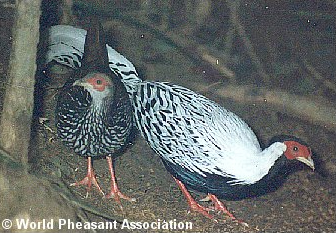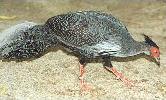 Other Names: No general names, see the list of subspecies for geographical names.
Other Names: No general names, see the list of subspecies for geographical names.
Range: South-western China, eastern Burma, southern Vietnam, southwestern Cambodia, southeastern Thailand, northern Laos and the island of Hainan.
Subspecies: 15 subspecies according to Johnsgard, 1999. True Silver Pheasant (Lophura nycthemera nycthemera) being the most commonly claimed in aviaries. The True Silver is the largest of the subspecies and is found in southeastern China. The other subspecies include the Lewis’ Silver Pheasant (L. n. lewisi), the Annamese Silver Pheasant (L. n. annamensis), the Boloven Silver Pheasant (L. n. engelbachi), the Bel’s Silver Pheasant (L. n. beli), the Berlioz’s Silver Pheasant (L. n. berliozi), the Ruby Mines Silver Pheasant (L. n. rufipes), the Rippon’s Silver Pheasant (L. n. ripponi), the Jones’ Silver Pheasant (L. n. jonesi), the Western Silver Pheasant (L. n. occidentalis), the Lao Silver Pheasant (L. n. beaulieui), the Fokien Silver Pheasant (L. n. fokiensis), the Hainan Silver Pheasant (L. n. whiteheadi), Szechwan Silver Pheasant (L. n. omeiensis) and the Rang Jiang Silver Pheasant (L. n. rongjiangensis).
Two additional subspecies that are often considered Silver Pheasants are the Crawfurd’s Kalij Lophura nycthemera crawfurdi and the Lineated Kalij Lophura nycthemera lineata. Recent DNA work published in the Ibis, notes that these races should be belong with leucomelanos instead of nycthemera. Click here to view the article in PDF format. If new data becomes available for nycthemera and leucomelanos, I will be sure to include it on this site.
Habitat: Diverse, both grasslands and bamboo, evergreen and decidous forests.
Description: The male True Silver L. n. nycthemera has a long black crest, a black chin and throat, with a glossy bluish-black belly. The rest of the body is white, with many black lines. Their tails can be quite long, with the central feathers pure white. One of the most noticeable features are the bright red face wattles which are used during courtship. Silvers do not acheive their brillant plumage until their second year. First year males often have many black markings on the chest, while the rest of the body is mostly brown with light gray streaks. Hens are drab, olive brown overall. There is much varation from hen to hen in the streaking of the belly, and I have never seen two hens exactly alike. Hens have a much smaller and paler face wattle. The bill is gray and the feet red. Immature Silvers resemble hens, but are often lighter or paler.
Breeding Season: Silver are among the first birds to begin laying. Don’t be surprised to find an egg when there is still snow on the ground! In Missouri, my birds would begin to lay in late February and early March, slowing down in May.
Breeding Age: Second year, but first years birds are often fertile.
Clutch Size: 6 to 15
Incubation Period: 26-27 days.

Jones’ Silver Pheasant, Lophura nycthemera jonesi

Annamese Silver Pheasant, Lophura nycthemera annamensis

Lewis’ Silver Pheasant, Lophura nycthemera lewisi



